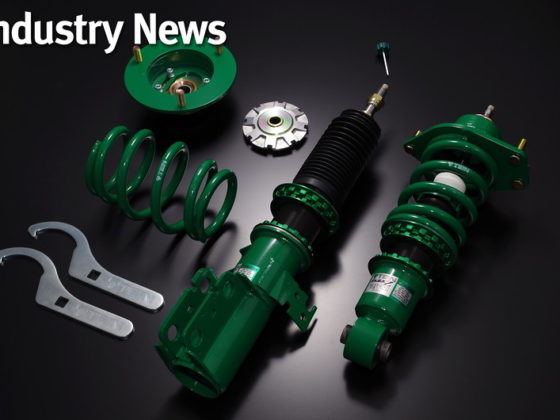,
 The nut itself should be removed with a special spanner. Cheap wads can use a screwdriver and a hammer. Judging by the damage to the spanner holes (make sure you use those and NOT the threaded holes for the locking ring), we were not the first to dig into this hub, so we went with the screwdriver. The hub, brake rotor and all, will now pop free.
The nut itself should be removed with a special spanner. Cheap wads can use a screwdriver and a hammer. Judging by the damage to the spanner holes (make sure you use those and NOT the threaded holes for the locking ring), we were not the first to dig into this hub, so we went with the screwdriver. The hub, brake rotor and all, will now pop free.  After cleaning off the old grease, we looked at our spindle. Yikes! That bluing is caused by overheated metal, usually caused by bad bearings. The stub axle also has its own bearing, a needle bearing pressed into the spindle itself, but that is in the middle of the upright, not out here on the stud. Proof then, that the inner wheel bearing had worn out.
After cleaning off the old grease, we looked at our spindle. Yikes! That bluing is caused by overheated metal, usually caused by bad bearings. The stub axle also has its own bearing, a needle bearing pressed into the spindle itself, but that is in the middle of the upright, not out here on the stud. Proof then, that the inner wheel bearing had worn out.  We did not have access to a press, so we decided to leave the outer races in place. This is not advised. However after a thorough cleaning, the old outer races were not gouged or pitted, so we think this is acceptable. There is also a grease seal on the inner bearing that should be replaced. The standard parts stores do not have listings for this seal. Instead, you can get it from Mega PDC which has a great selection of parts for your Isuzu. Our seal was actually in very good shape, so we carefully pressed it out, cleaned it, and reused it (and not because we forgot to order one when we were doing this repair). To pack the bearings with grease, we used the old-school hand pack method, doubling up on a our rubber gloves to prevent from tearing them as we packed the grease. Assembly is the reverse of disassembly, except for torquing the hub nut. Isuzu's torque spec is actually a resistance spec. A spring gauge is supposed to be used to pull on a wheel stud. It should spin with 7N of resistance, loosening or tightening the nut as needed. If you don't have a spring gauge, tighten it until you feel a small amount of resistance when you spin the hub and can properly attach the locking ring.
We did not have access to a press, so we decided to leave the outer races in place. This is not advised. However after a thorough cleaning, the old outer races were not gouged or pitted, so we think this is acceptable. There is also a grease seal on the inner bearing that should be replaced. The standard parts stores do not have listings for this seal. Instead, you can get it from Mega PDC which has a great selection of parts for your Isuzu. Our seal was actually in very good shape, so we carefully pressed it out, cleaned it, and reused it (and not because we forgot to order one when we were doing this repair). To pack the bearings with grease, we used the old-school hand pack method, doubling up on a our rubber gloves to prevent from tearing them as we packed the grease. Assembly is the reverse of disassembly, except for torquing the hub nut. Isuzu's torque spec is actually a resistance spec. A spring gauge is supposed to be used to pull on a wheel stud. It should spin with 7N of resistance, loosening or tightening the nut as needed. If you don't have a spring gauge, tighten it until you feel a small amount of resistance when you spin the hub and can properly attach the locking ring. While we finished up the bearing, we noticed a bit of oil spray on the bottom of one of the radiator hoses. This spray was also on the radiator and airbox. The oil turned out to be ATF. The transmission cooler lines are on the other side of the truck, so this left only one possibility: a power steering leak. The high pressure hose runs right beneath this hose and it too was covered in fluid.
While we finished up the bearing, we noticed a bit of oil spray on the bottom of one of the radiator hoses. This spray was also on the radiator and airbox. The oil turned out to be ATF. The transmission cooler lines are on the other side of the truck, so this left only one possibility: a power steering leak. The high pressure hose runs right beneath this hose and it too was covered in fluid. Of course whatever didn't spray up, dripped down and made a big mess all over our undercarriage. The little puddle on our garage floor is what first tipped us off to a potential problem. Also, a garage! No more parking lot brake pad swaps or like we were doing two pages ago!
Of course whatever didn't spray up, dripped down and made a big mess all over our undercarriage. The little puddle on our garage floor is what first tipped us off to a potential problem. Also, a garage! No more parking lot brake pad swaps or like we were doing two pages ago!Normally, a power steering hose is a relatively simple job. On a scale of 1-10, replacing a high pressure power steering hose is about a 3: takes an hour or two, but can be done with hand tools and some patience. In the VX, it was a 9. It ended up being the single worst job I've ever had to do on a car (and god willing ever will do). What made it suck so much? Well, you'll just have to come back and find out later on…



